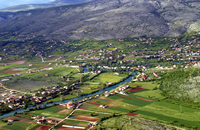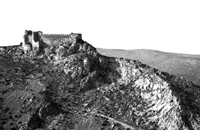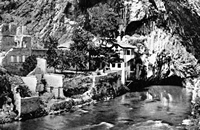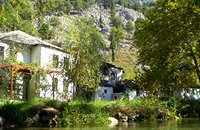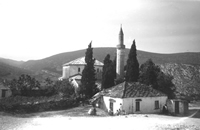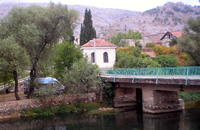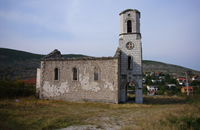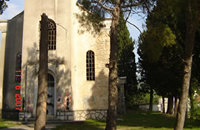BLAGAJ
Blagaj, the old Herzegovinan town, is placed 12 km south-east of Mostar. Because of the nearness of the Adriatic Sea (about 45 km) and the low altitude (45m), it has the Mediterranean climate.The average temperature is 17 'C (in summer 26 'C and in winter 8'C). Blagaj has a lot of sunny days, almost 200 a year. The Buna River flows through the town, whose ice cold water (8 'C) is very refreshing during long, hot summers.The Buna spring is one of the most powerful springs in Europe( average 43000 l/s ).Today, Blagaj has about 3000 inhabitants.
History
The area around Blagaj was inhabited 7000 years B.C. and people have never stopped living here eversince. Only the type of settlements change throught history from cave and village followed by an Illyrian fortress, Roman Castrum, feudal residency,the seat of kadhi,wall town and at last a town.this unusal script of human existence started with the Zelena pećina(Green cave) in the neolithic.The Romans turned the Illyrian settlement from I and II century B.C. into castrum.- After the Roman rule, the town was reconstructed by the Mediaeval Bosnian State. It became the center of the province of Hum, governed by the Bosnian duke Herceg Stjepan Kosača. Blagaj was under the Ottoman and Austro-Hungarian rule.Attractions
There are so many historical amenities in Blagaj and its surroundings.
Herceg Stjepan Kosača fortress
Originally the town was built where the Illyrian settlements from the 2nd and 1st century B.C. were once established, and was then fortified by the Roman Empire. By re-arranging and repairing the town-walls of Kosača, the Bosnian aristocrats built the medieval castle in the 15th century. Thus, the town got its oval basis and very massive walls which were, at places, 15 m high. In the town there were a treasury, a prison and two water reservoirs. During the Turkish period the castle was reinforced by two big towers and five fortresses. A small mosque was built too.The town was repaired and enlarged several times in 1699 and in 1728. In 1827 it was badly damaged in the earthquake and in 1835, when it lost its strategic importance, it was deserted . By the decision of the Commission to Preserve National Monuments of BiH, issued in 2003, the fortress was proclaimed a national monument of Bosnia and Herzegovina.
The fortress can be accessed on foot and the entrance is charge free. It takes around 40 minutes of easy walk to get there from the river camp Aganovac. Going across a slight upward slope and a very original path, you will come to the fortress that commands a wonderful view of the wider area of the Buna and Neretva valleys.
Tekke (Dervish house)
Placed under the high cliff, next to the Buna River spring, the tekke (dervish house) stands as a jewel of the early Ottoman period in Bosnia and Herzegovina.This house/monastery was built in the late 15th or early 16th century, no later than 1520. That is the place where dervishes performs the spiritual prayer (zikr).The tekke of Blagaj belonged to various dervishes' orders, among them the Bektashi order, the Halveti order, the Kadariti order. Today it belongs to the Nakshibendi order. The tekke building was rennovated several times and got its present appearance in 1851. This is one of the most mystical places in Bosnia and Herzegovina, and it is open to visitors throughout the year. It has a beautiful garden overlooking the source of the River Buna where you can have cold drinks, tea and Turkish coffee. Since this is a religious site, it is recommended that the visitors respect some rules of conduct, which you will see at the entrance door. Since 1952, Tekija has been protected by the State as the monument of a high historic and cultural value. The dervish house is placed at 15 minutes walk distance from the river camp Aganovac . The entrance is feecharged.
Green cave
The oldest evidence of human existence in this region was found at the locality of the Green Cave, on the cliff above the Buna River. The vessels found in the cave date back to the Neolithic Age. ( 3000 – 2800 B.C.)
The Velagic Family Complex
An ensemble of the Bosnian oriental houses owned by the Velagic family, the old family from Blagaj. It was built in the 17th century, being a beautiful example of the Ottoman residential architecture. The complex is open for visitors, and the entrance fee is charged. It is at 10 minutes walk distance from the river camp Aganovac.
The Mosque of Sultan Sulejman (The Emperor's Mosque)
The mosque in Blagaj was built in 1520-1521 by Sultan Sulejman II the Lawmaker , after whom it got its name. The mosque has all features of a domed mosque. During the war in BiH it was exposed to shelling and damaged , and reconstructed after the war. It is at 5 minutes walking distance from the river camp Aganovac in the centre of the town.
The Bridge of Karadjoz-Bey
A stone, five-arched bridge over the River Buna that was built in 1570 by the famous benefactor Mehmed-Bey Karadjoz. The bridge stands in the immediate vicinity of the Sultan Suleyman Mosque.
Hamam (Public Baths)
It was built in late 16th or early 17th century. As it was a custom at the time, the baths had separate spaces for men and women. It is placed next to the Karadjozbey Bridge, at 10 minutes walk distance from Aganovac river camp.
The Leho Bridge
The bridge at Donja mahala was built before 1664. During the reconstruction conducted before the war (in the 1980's), the original appearance of the bridge was significantly changed. It stands in the immediate vicinity of the camp.
Orthodox church
Built in the period 1892-1893. Unfortunately, it was destroyed, being exposed to ravages of shelling and war operations. Its reconstruction has been awaited. Hopefully it will begin soon.
Catholic church
The catholic church was built at the beginning of the 20th century (1906-1908.), while its belfry was built later 1933. Due to war-time operations and shelling, it is damaged.
